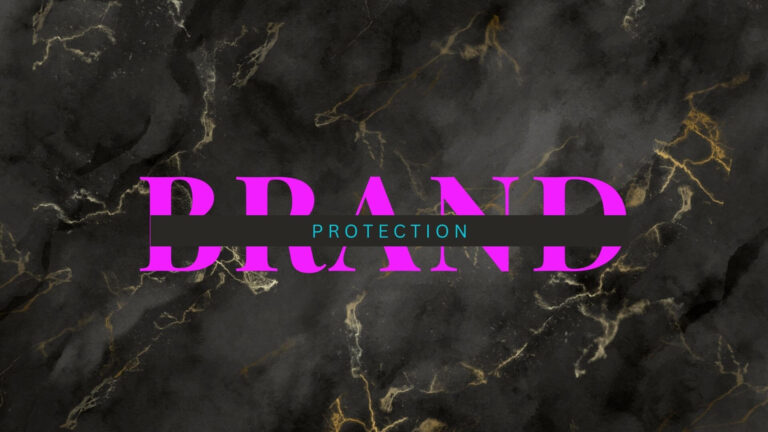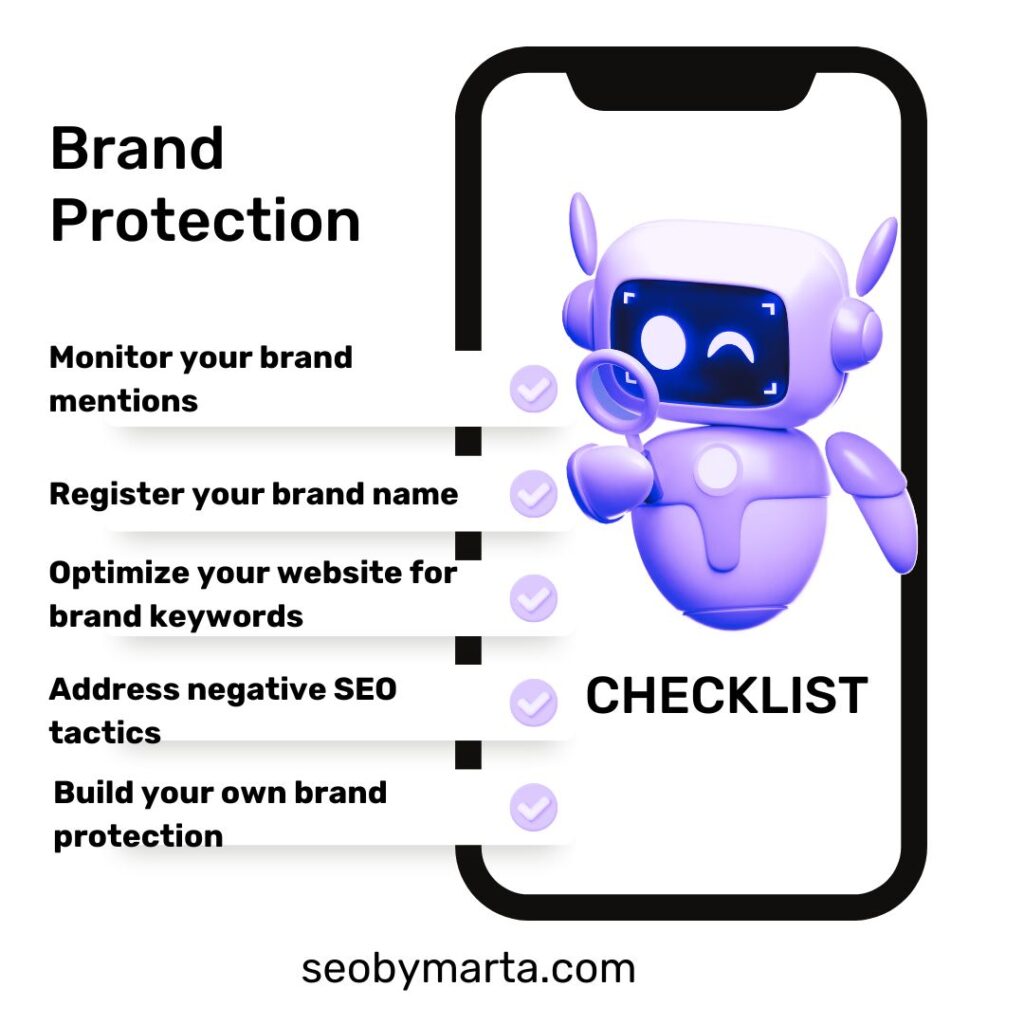In today’s digital landscape, your brand is more than just a name; it’s your reputation, identity, and promise to users. Protecting and leveraging branded traffic is a critical element of your business that ensures your brand maintains its integrity and visibility. This guide will delve into the essentials of Brand Protection. We’ll explore the different types of brand protection methods—free and paid—and provide practical tips on creating a robust satellite brand protection website

What is Brand Protection?
Brand protection in SEO involves implementing strategies to ensure that your brand is properly represented in search engine results and that your online reputation is safeguarded. It involves a combination of legal, marketing and SEO actions to ensure the brand maintains its visibility and integrity online.
Brand protection implementation aims to protect branded keywords and branded traffic, which refers to the users who visit a company’s online platforms through searches and interactions specifically related to the brand’s name or products.
What Are Branded, Semi-branded Keywords?
Branded Keywords are specific terms or phrases that include a company’s brand name. These keywords are used by individuals who are already aware of the brand and are actively seeking information, products, or services associated with it. Examples of branded keywords include:
- “Nike”
- “Casumo Casino”
- “Stake”
Semi-branded keywords are phrases that combine the brand name with generic terms. These keywords attract users who are aware of the brand and are looking for more specific products or services related to the brand. Examples of semi-branded keywords include:
- “Nike women’s running shoes”
- “Casumo Welcome Bonus”
- “Stake Casino App”
What is Branded Traffic?
Branded Traffic refers to website visitors who arrive at a company’s online platforms after searching for branded and semi-branded keywords.
Legal Aspects of Brand Protection
Trademarks and copyrights are crucial legal tools for brand protection, executed mainly by the legal team at a business’s start. They secure your brand identity and protect your creative works.
Trademarks
Trademarks protect symbols, names, and slogans used to identify goods or services. Register your brand’s name, logo, and other marks to secure exclusive rights and to take legal action against unauthorized use.
Copyrights
Copyrights protect original works of authorship, such as written content, images, and videos. It provides exclusive rights to use and distribute your content. You can use copyright claims to remove infringing material from websites and platforms.
Brand Protection Methods
Brand protection encompasses various strategies and tools to safeguard a brand’s reputation, intellectual property, and online presence. These can be broadly categorized into free and paid methods:
Free Methods of Brand Protection
- Social Media:
Creating active profiles on major social media platforms like Facebook, Twitter, Instagram, and LinkedIn.
Benefits: Most Social Media platforms are free and will rank high in the search results. Creating business accounts on them allows you to monitor brand mentions, engage with your audience, and respond promptly to negative comments or misinformation.
- Wikipedia:
Ensuring your brand has a Wikipedia page that is regularly updated with accurate and relevant information.
Benefits: The Wikipedia profile page is free and allows you to control the narrative about your brand and provide authoritative information that can rank highly in search results.
- Trustpilot
This free customer review platform allows businesses to collect and respond to customer feedback.
Benefits: Enhances brand credibility by showcasing genuine customer reviews. Allows you to address negative feedback promptly, demonstrating good customer service.
- Google My Business (GMB)
GMB is a free tool that lets you manage your business information across Google, including Search and Maps.
Benefits: It improves local SEO by making your business more visible in local search results. It collects and displays customer reviews, which can influence potential customers. It enables you to respond to reviews, helping to manage your brand’s online reputation.
Paid Methods of Brand Protection
- PPC (Pay-Per-Click) Advertising:
Branded Keyword Bidding: Bid on your branded keywords to ensure your ads appear at the top of search results.
Benefits: Prevent competitors from capturing your branded traffic by “monopolising” the top results and ensure that searchers find your official sites first.
- SEO Satellite Brand Protection Websites:
Creation of Additional Websites: Develop satellite sites or microsites that rank for your branded terms in your core markets. The satellite brand protection sites aim to rank for your branded keywords below your main website.
Benefits: These satellite sites aim to rank for your branded keywords just below your main website, providing an extra layer of control over search engine results pages (SERPs). This strategy ensures that accurate, positive, and brand-controlled content dominates the search results, safeguarding your brand from competitors and unauthorised entities.
Benefits of Brand Protection
Brand protection is vital for controlling your brand’s online narrative and preventing misuse of your brand identity. A strong brand protection strategy safeguards revenue and reputation by engaging customers effectively. Key benefits include:
1. Dominate Search Results
Optimizing for branded keywords will fill search results with favourable information about your brand. You can control user journeys and guide them to accurate and beneficial content about your brand.
2. Prevent Unwanted SERP Blockage
Brand Protection activities can help you to stop competitors and unauthorized entities from filling SERPs with misleading content. Your brand will have accurate representation online, and you can ensure search results reflect your brand positively.
3. Protect Branded Keywords in Search Ads
Bidding on your branded keywords is an essential part of brad protection. It ensures your ads appear prominently to users searching for your brand.

How to Build SEO Satellite Brand Protection Websites
Creating a robust brand protection strategy involves building and optimizing websites that safeguard your brand’s online presence. Your SEO department should be responsible for handling this task, or you can hire a specialized SEO agency. SEO for a satellite website is similar to that of any other website. However, there are some essential points for building your SEO brand protection websites that are to be highlighted:
1. Conduct Keyword Research
- Identify Branded Keywords: Use Google Search Console to find the best variations of your brand name and related terms.
- Target Semi-Branded Keywords: Include phrases that combine your brand with generic terms.
2. Choose the Right Domain Name
- Exact Match Domains: Select domain names that match your branded keywords and some generic keywords relevant to your brand. For example, if your brand is “BrandX,” a satellite site domain might be “BrandXReview.com” or “BrandXbonus.com.”
- Consistency: Ensure the domain name is consistent with your brand identity and easy for customers to remember.
3. Choose the Best Markets
- Use your internal data and resources to choose the most profitable market for your brand protection websites.
4. Plan Your Content Strategy to cover all the branded topics
- Content Topics: Identify key topics related to your brand that will provide value to your audience.
- Authoritative Articles: Write in-depth articles about your brand, products, offers, payment methods and the industry.
- Product/Service Pages: Develop detailed pages for each product or service optimised for search engines.
- FAQs: Create a comprehensive FAQ section addressing common queries related to your brand. Infovle, you can ask your customer support team to find the common users’ questions.
5. Include Calls to Action (CTA)
- Driving Traffic: Include clear and compelling CTAs that direct visitors to your main brand site. This helps drive traffic from the satellite sites to your primary site.
- Affiliate Links: Use affiliate links to measure the success and effectiveness of your satellite sites in driving traffic and conversions.
6. Build Quality Backlinks
- Earn Reputable Backlinks: Gain backlinks from authoritative and relevant websites to boost your site’s authority.
- Do not leave footprints: Do not crosslink your brand protection sites or link to them from your main brand site. Google could see this as an attempt to manipulate the system.
Whether managed by your SEO department or an external SEO professional, following the steps outlined above for your satellite website and actively monitoring will help protect and enhance your brand’s reputation in the digital marketplace.
Conclusion – Your Brand Protection Checklist
Here are some key steps to help protect your brand:
- Monitor your brand mentions: Use tools such as Google Alerts and social media monitoring platforms to keep track of any mentions of your brand online. This will allow you to quickly address negative comments or reviews before they harm your brand reputation.
- Register your brand name and trademarks as keywords: Ensure that your brand name and trademarks are registered as keywords in your SEO strategy. This will help to prevent competitors or malicious entities from bidding on your brand terms and diverting traffic away from your website.
- Optimize your website for brand keywords: Make sure that your website is optimized for your brand keywords, including your brand name, product names, and any other relevant terms. This will help improve your website’s visibility in search engine results and ensure that users searching for your brand can easily find it.
- Monitor and Address negative SEO tactics: Look for any negative SEO tactics against your brand, such as negative reviews, fake social media profiles, or spammy backlinks. Take swift action to address these issues and protect your brand reputation.
- Build your own brand protection: Creating a robust brand protection strategy involves building and optimizing websites that safeguard your brand’s online presence.




